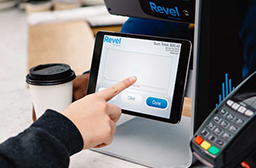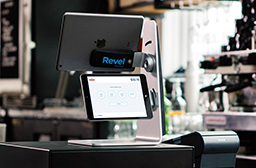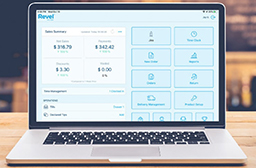Revel Systems is now part of Shift4 and this website will soon redirect to Shift4.com.
Call Sales: +1 (833) 437-3835
Inventory Management Efficiency Guide
If your business is relying on manual inventory management or not fully utilizing the tools you have, you’ve likely run into issues like running out of stock or being overstocked.

Efficient Inventory Management
Inventory management, in some way or another, has been around since the first restaurant and retail experiences. After all, you’ve got to have a product in order to exchange it for profit. But today, as businesses and their offerings scale in size and complexity, efficient inventory management, and the tools to make that a reality, are more important than ever. Read on to learn more.
1. Use an Inventory Management Tool
First things first, your business should be using technology to manage inventory. Using a cloud-based inventory management tool gives your business the ability to store information online and access that information anywhere. Today, many POS systems include inventory management tools, streamlining the tools your business needs. Revel, for example, has a built-in inventory management feature that makes adding and monitoring your inventory easy to do from a single dashboard. So if you’ve got Revel today, you have powerful tools to manage your inventory.
Once you have an inventory management tool, your initial inventory input plays a big role in your ongoing management. Before you jump in and begin entering inventory, sit back and ask yourself a few questions:
- Are you going to list each product individually?
- Or, does it make sense to use categories and subcategories to organize?
- Do you have multiple versions of the same item, i.e. sizes or colors?
- Do you want to manually enter items? Or utilize a spreadsheet to upload many items at once?
Once you think about these questions and have an understanding of how you want to organize your inventory, you should begin entering inventory. With Revel, you can manually input each category and item, or use a spreadsheet template to bulk-upload large quantities of inventory.
Maintain strict ongoing standards. After your initial inventory input, make sure that any subsequent inventory additions follow the same methodology you used. This will ensure consistency across your tracking and reporting and will provide you with the best data possible.
2. Tracking Inventory & Reporting
One of the most impactful components of inventory management is the advanced tracking and reporting. When using an excel sheet to monitor inventory, you must draw conclusions and trends for yourself. However, when using powerful inventory management software, you can easily follow inventory reports and rely on data-backed insights.
Use matrix inventory to keep things straight. Especially helpful for large retail inventories, a matrix inventory helps your business track items that have variations. For example, if your hat shop has multiple sizes of each style of hat, you can utilize a matrix inventory tool to organize each item, size, and color.
One example of using your tracking and reporting to impact your bottom line is using your inventory management software to identify slow-moving inventory. You have the ability to use your inventory to identify:
- Inventory turnover
- Average days to sell inventory
- Holding costs
- Gross profit
- Forecasting opportunities
You can also use inventory management to identify shrink. Understanding what you actually have on hand compared to what you believe have on hand is your shrink. Shrink can come in many forms: theft, human error, or mismanaged inventory. Whatever the cause, the larger the shrink, the bigger the problem for your business. Use precise inventory control features including real-time tracking to keep an accurate view at all times.
Tip! To learn more about inventory best practices, check out this blog.
3. Keep the Right Inventory Levels
You want to have the items your customers want in stock, this goes without saying. But how do you ensure your kitchen or storage room are well stocked but not overstocked? Use your reports from step two to inform your ordering.
Avoid being out of stock. It happens to almost every business. You run out of a popular sweater or famous beef brisket sandwich. However, by setting up a monitoring feature like Revel’s low stock alerts, your business can stay ahead, and make sure you have the optimal levels at all times.
Set low stock alerts for your products. If an item falls below the set threshold, you’ll receive an automated notification that it’s time to reorder. This can be done for individual products or in bulk. See how.
Maintain optimal stock levels. On the flip side, keeping too much of any item can lead to waste. Pay attention to trends and make adjustments to your ordering based on changing trends.
- If an item is seasonal, plan your menu accordingly.
- If an item begins losing popularity, pay attention and slow your orders down to match.
4. Define and Document Your Process
One thing that many businesses often neglect to do is creating a plan for ongoing measurement and evaluation. To get the most out of your inventory management tools, you should create a realistic plan for ongoing evaluation and adjustment.
Figure out how much time is required to review data and how often it makes sense to review it. For some businesses, this may be a weekly review, and for others, it may be a monthly deep dive into the data. Whatever the timeline you should:
- Define Your Process. This means putting time on your calendar, or on the other managerial staff’s calendars, to review data and make necessary changes.
- Document Your Process. After you define how you are going to analyze your reports, put together a document outlining this process. It could be as simple as one sheet with steps such as:
- View sales reports
- Note top three performers
- Note bottom performer
- Note total sales in week
By keeping consistent records, you have the ability to track data week over week and make decisions based on your findings. For example, if you notice an item on your menu is the bottom performer, week after week, you may want to consider not reordering the ingredients anymore and removing the item from your menu.
5. Automate
Automation helps any business cut down on time spent and reduce errors. With smart software, your business can automate many pieces of inventory management. From monitoring inventory to aiding with reordering, take a look at the ways your business can use included features to streamline your inventory processes.
If you have not yet updated your inventory management features, spend a little time with your inventory management settings, updating details:
- Automate low stock monitoring. As previously mentioned, Revel makes it possible to automate your low stock monitoring. Set thresholds for your inventory and every time an item dips below the set limit, you’ll receive an alert. This ensures that you never run into the dreaded out of stock situation – and always have what your customers want.
- Automate purchase orders. Add vendor details for automatic purchase order creation. You can then cut down on time spent each time you need to reorder, and with a click of a button, generate a new purchase order based on the products that have fallen below your set limits.
- Unify your processes. By tying in your inventory, sales, and customer data, your business has a better picture of the entire business. With this full picture, you have the ability to make better decisions for your business. From forecasting trends to identifying low performers in your inventory, it helps to utilize a single platform to draw insights.
FINAL THOUGHTS
Inventory management is an important part of managing a successful business. Maintaining ideal levels of your inventory make your business more efficient, and precise inventory management makes this possible. If you don’t have clear inventory management processes in place, take time to evaluate and organize. With Revel, you have the right tools to improve the way you manage your inventory.



